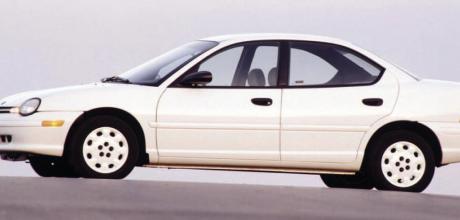Guilty Pleasure 1995 Chrysler Neon Mk1
Disposable cars are, by their nature, disposable. Vehicles bought on a budget face a rapid decline into the abyss, often just one big bill away from a meeting with a burly chap with a car baler and a German Shepherd named crusher. It’s why the first-generation Chrysler Neon is a rare sight, even in its homeland, where it was sold as the Plymouth or Dodge Neon. This new kid on the block replaced the Plymouth Sundance and Dodge Shadow, two of the last bastions of the old K-car platform.
Significantly, the Neon wasn’t unveiled in LA, New York or Detroit, but at the Frankfurt motor show in 1993. Speaking at the event, the then-president of the Chrysler Corporation, Bob Lutz, said: ‘There’s an old saying in Detroit: “Good, fast or cheap. Pick any two.” We refuse to accept that.’ Chrysler had returned to Europe in 1987 with modest export forecasts, but the Neon was to take the American giant up a gear. The plan was to export 20,000 to 30,000 Neons a year, up to 10% of the Belvidere factory’s maximum capacity. Lofty ambitions for a budget-driven econobox from Illinois.
First, the Neon faced the bright lights of the American market. The design borrowed heavily from the brilliant Dodge Neon concept of 1991, although the sliding ‘suicide’ doors, electric canvas roof, trash compactor and retractable boot failed to make production. A proposed fuel-injected twostroke engine, considered at the car’s conception, was also left on the drawing board. Crucially, the bug-eyed frontal styling made the transition from concept to reality, with the then-chairman Lee Iacocca keen to distance the Neon from what he described as ‘Japanese generic’. This car was Iacocca’s personal response to those who claimed the American auto industry couldn’t build a car to tackle the influx of Japanese cars; one of the engineering offices displayed a banner reading ‘COUNTERATTACK’.
At its launch in 1994, the basic Chrysler Neon cost a cheeseburger, fries and milkshake shy of £9000, the equivalent of around £5600 in mid-1990s money. That’s $9k for a car with a 2.0-litre 16-valve engine developing more power than most of its rivals, frameless windows, a cab-forward design to create more interior space, and more kit than you’d expect from a car at this end of the market. In a word: more. Even a ‘nicely loaded’ Neon cost around ‘twelve-five’, to borrow two phrases from Chrysler’s memorable ad campaign.
The plan was to build a car for $4000 and sell it for $8000; Chrysler missed the base price by $1000, but was making $1000 per unit sold when the first-generation Neon bowed out. That’s including rebates and warranty costs. Rear drum brakes, keepfit rear windows and the shape of the rear side windows kept production costs to the minimum. Buyers were probably less enthusiastic about the window design when they discovered the glass couldn’t be lowered further than half-way.
Americans took the cheap and cheerful econobox to their hearts, with some two million units of all Neons sold over a decade of production. Its friendly face helped; there are shades of the Renault Twingo in the frontal styling, with more than a hint of Baymax. No wonder Chrysler described the Neon as ‘highly huggable’. Even the colours were bright and optimistic; Nitro Yellow-Green, Aqua and Strawberry are as delightful and 1990s as they sound. Car & Driver said: ‘For $11,552, we got a plain white five-speed with dog-dish hubcaps, great room inside, dual airbags, and plenty of driving fun. The seat cloth looks a bit frugal, the rear seat is hard as a park bench, and the undamped trunk lid clangs when slammed shut like a reject from a cymbal factory. But we still like the car. A lot.’
The Chrysler Neon finally arrived in the UK in 1996, a year after its European debut. It hit the automotive headlines, not just for its Twingo-like expression, but for the fact that it offered Ford Mondeo space for Escort money. A price of £11,595 for the Neon LE pitched it against an Escort 1.4 LX and nearly £1500 below a base-spec Mondeo 1.6 Aspen. Not bad for a car with a 2.0-litre engine and more toys than a Walmart at Christmas. Something got lost in translation. In America, where college grads drive Toyota Camrys, the Neon was a small, compact car. Over here, the Neon was too big and sensible for cash-strapped students, so Chrysler UK pitched it at recent retirees. CAR called it a ‘good effort’, but it wasn’t long before the Neon’s lights dimmed in the wake of budget-led rivals from Europe and South Korea.
It lost its way. Head gasket and automatic transmission issues, rust and the UK’s rather sniffy attitude to American imports have put the first-gen Neon on the brink of extinction. One must wonder if things would have been different had Chrysler adopted the American approach to marketing the Neon; do you want fries with your dayglo paint, grey bumpers and ‘styled’ steel wheels? A sub-£10k price tag to rival smaller Protons, Ladas, FSOs and Daewoos. Wishful thinking on my part, not least because I dream of owning one in all its povertyspec glory. It’s quite lonely in my Neon wilderness.


